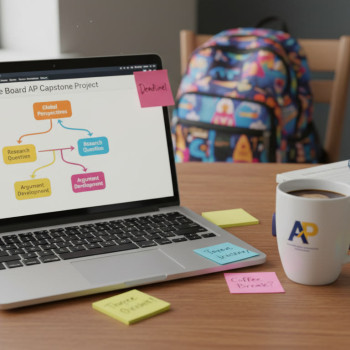Why a Weekly Retrospective Is Your Secret Weapon for AP Success
Imagine this: it’s Sunday evening. You make a cup of tea, pull up your planner, and spend 20 minutes looking back over your week. Not to stress or to re-live every missed question, but to notice patterns — the strategies that helped, the distractions that sabotaged you, and the tiny experiments you want to run next week. That pause, that gentle look-back, is a weekly retrospective. It’s simple, human, and ridiculously effective for students preparing for AP exams.
AP prep is not just about hours logged; it’s about direction. A weekly retrospective turns scattered effort into purposeful progress. It helps you keep practices that build momentum, kill habits that waste time or confidence, and improve the techniques that need tuning.

Who this is for
Whether you’re juggling AP Biology labs and world history essays, balancing multiple APs, or preparing for one high-stakes exam — this method is for you. It works for students who like structure and for those who prefer flexibility. It’s productive for self-studiers, for classroom learners, and for students who pair their work with 1-on-1 tutoring or small-group lessons.
The Three-Part Framework: Keep, Kill, Improve
At the heart of a weekly retrospective are three powerful questions. Answer them honestly, write them down, and turn answers into actions.
- Keep — What helped this week? Which habits, resources, or routines are worth preserving?
- Kill — What drained your time or confidence? Which distractions or methods consistently failed?
- Improve — What can you tweak to get better results next week? Small, specific adjustments beat vague resolutions.
How long it takes
Plan for 15–30 focused minutes. Set a short timer, and treat the retrospective like a mini-lab: observe, hypothesize, test next week, repeat. The point is rhythm — consistency beats marathon overhauls.
Step-by-Step: Running Your Weekly Retrospective
Here’s a practical routine you can follow every weekend. I’ve included examples tailored to AP students so the steps feel real, not abstract.
Step 1 — Gather quick data (5 minutes)
Before you reflect, collect two or three quick pieces of evidence from your week. This could be:
- score or percent correct on a practice set or progress check
- total study hours logged on your phone or planner
- a note of things that felt particularly hard or unusually easy
Example: “I scored 68% on Friday’s AP Physics progress check, spent 6 hours studying, and missed mostly multi-concept problems.”
Step 2 — Answer the three questions (8–12 minutes)
Write one clear sentence for each of the Keep, Kill, Improve prompts. Be specific.
- Keep: “Weekly problem sets on past free-response questions helped me think structurally.”
- Kill: “Scrolling social media between practice problems — I lose focus for at least 20 minutes each time.”
- Improve: “Break study sessions into 40-minute focused windows with a 10-minute reflection and a quick active recall review before bed.”
Step 3 — Turn decisions into a simple plan (5–10 minutes)
Convert each Keep/Kill/Improve into an action you can follow next week. Use the SMART principle but keep it small.
- Keep → Action: “Schedule two 1-hour practice sessions with FRQ focus on Tuesday and Thursday.”
- Kill → Action: “Install a ‘Focus’ app during study blocks and put my phone in another room.”
- Improve → Action: “Start 40/10 Pomodoro blocks and add a nightly 5-minute spaced-recall note in my phone.”
Concrete Examples by AP Subject
Different AP courses have different rhythms. Here are real examples of retrospectives for common AP subjects so you can adapt the method to your classes.
AP Calculus — Focus on Conceptual Mistakes
- Keep: Doing one mixed problem set twice to catch careless errors.
- Kill: Purely procedural practice without explaining steps aloud.
- Improve: After each mistake, write a 2-line explanation of the conceptual gap and make one similar problem the next day.
AP Biology — Balance Depth and Breadth
- Keep: Weekly flashcard review of vocabulary and pathways.
- Kill: Passive re-reading of the textbook without self-testing.
- Improve: Add one 20-minute “big-picture” mapping session where you draw and connect systems (e.g., cellular respiration + photosynthesis) to reinforce links across units.
AP U.S. History — Improve Argument Skills
- Keep: Timed practice thesis statements and evidence planning.
- Kill: Writing entire essays without an outline first.
- Improve: Create a two-column chart: thesis + 3 pieces of specific evidence. Practice for 15 minutes three times a week.
How to Measure Progress: Small Data That Matters
Progress doesn’t require huge metrics. Track a few signals consistently and they’ll tell a story.
| Signal | What It Reveals | How to Track (Weekly) |
|---|---|---|
| Practice Score (Topic) | Mastery of specific content or skills | Record percent correct and types of errors |
| Study Duration | Consistency, not just intensity | Log focused hours (exclude distracted time) |
| Retention Check | Long-term memory vs short-term cram | Use spaced recall: did you remember key facts 1 week later? |
| Confidence Rating | Mental readiness and stress level | Rate confidence 1–5 after practice |
Example weekly log entry:
- Practice Score (Calculus Integrals): 78% (lost points on substitution identification)
- Study Duration: 7 focused hours
- Retention Check: Correctly recalled core integral rules after 6 days
- Confidence: 3/5
Common Pitfalls and How to Kill Them
Retrospectives are simple to start but easy to sabotage. Here are familiar traps and practical fixes.
Pitfall: Vague Resolutions
“Study more” is a mantra of doom. Make it specific: what, when, and how long. Instead of “study more chemistry,” plan “two 45-minute practice sets on Acid–Base titration with review on Sunday night.”
Pitfall: Over-correction
After a bad week, students often reset everything and burn out. Keep one stabilizing routine (like nightly 10-minute review) so you don’t lose momentum.
Pitfall: Measuring Only Time
Time is important, but quality matters most. Track outcomes (scores, types of errors) alongside time spent.
Using Technology Without Losing Focus
Apps can help you track, block distractions, and schedule, but they can also become an extra source of stress. Use tech to automate simple tasks.
- Use a calendar or planner to schedule focus blocks and practice tests.
- Use a distraction-blocker during those blocks.
- Use a simple habit tracker to mark whether you completed your nightly recall or not.
Reminder: technology should reduce cognitive load, not add to it. Keep tools minimal and functional.
When to Bring in Personalized Help
There are moments when an outside pair of expert eyes accelerates learning. If your retrospective keeps revealing the same struggle — repeated errors on FRQs, confusion about a concept despite multiple approaches, or chronic test anxiety — a tutor can help diagnose root causes and adapt plans.
Sparkl’s personalized tutoring offers tailored study plans, expert tutors, 1-on-1 guidance, and AI-driven insights that can plug into your weekly retrospective. For example, a tutor can help you convert an “Improve” note into a practice sequence or simulate timed conditions so your weekly plan is both realistic and targeted.
Sample Weekly Retrospective Template (Fillable)
Use this quick template after your week of study. Keep a running document or a dedicated notebook for consistency.
| Field | Example Entry | Your Entry |
|---|---|---|
| Week Ending | Sun, Oct 5, 2025 | |
| Top Evidence | 68% on AP Physics Progress Check | |
| Keep | Two timed practice sessions worked well | |
| Kill | Studying right before bed without active recall | |
| Improve | Add 20-minute concept mapping on Sundays | |
| Actions for Next Week | Schedule Tue/Thu practice, nightly 5-min recall, block phone during study |
Quick Experiments You Can Try Next Week
Retrospectives are about testing ideas. Here are bite-sized experiments — treat each like a hypothesis you’ll check the next week.
- Swap one passive review session for a timed practice. Hypothesis: Active practice reveals gaps faster.
- Replace a 90-minute study block with two 40-minute blocks and a 10-minute review. Hypothesis: Shorter bursts increase focus and retention.
- Teach one concept aloud to a friend or imaginary audience. Hypothesis: Teaching exposes shaky understanding quickly.
How to Scale Retrospectives When You’re Taking Multiple APs
If you’re juggling two or three APs, don’t reflect on everything every week — rotate subjects. For example:
- Week 1: Deep retrospective for AP Chemistry + light check-ins for others
- Week 2: Deep retrospective for AP English + light checks for others
- Week 3: Deep retrospective for AP Calculus + light checks for others
Rotation keeps the practice sustainable and prevents burnout.
Retrospective Role-Play: A Short Example Conversation
Use this script to guide a brief in-person or tutor-led retrospective. It models a constructive tone — curious, not harsh.
- Student: “This week I practiced four FRQs but my score was still low on synthesis prompts.”
- Tutor/Partner: “What specifically tripped you up on the synthesis prompts?”
- Student: “I ran out of time and couldn’t organize evidence.”
- Tutor/Partner: “Okay — keep the timed practice, kill unstructured writing, and improve by outlining evidence in two minutes before writing.”
Turn that into a plan: two timed FRQs with a 2-minute outline requirement on Tue/Thu.
The Emotional Side: Keeping Resilience in Your Retrospective
Preparing for APs is as much emotional work as intellectual work. A weekly retrospective is also a place to check on morale. Add a small emotional check to your template: a one-line note like “Feeling: energized / stuck / anxious.”
If you notice repeated low-confidence weeks, your Improve section should explicitly include micro-self-care actions: clear sleep goals, two social breaks a week, or a 5-minute breathing routine before each timed practice. Small actions compound.
How Tutors and Personalized Support Fit In
Personalized tutoring is not a magic shortcut, but it changes how you run retrospectives. A good tutor helps translate notes into a targeted practice sequence, spots patterns you might miss, and offers accountability without pressure.
Sparkl’s personalized tutoring model can amplify your weekly retrospective by delivering tailored study plans, AI-driven insights that identify weak topics, and 1-on-1 guidance that turns a vague “Improve” note into a concrete two-week drill. If your retrospective keeps highlighting the same issue, working with an expert tutor for a short block — for example, three focused sessions — can help recalibrate your next few retrospectives so you make measurable gains.
End-of-Term Retrospective: How to Synthesize Monthly Insights
Every four weeks, pull together your weekly retrospectives and look for trends. Create a one-page summary with the top three keeps, the top three kills, and the top three improvements that actually moved the needle. Use that summary to plan the next month.
Final Checklist: Keep This by Your Desk
- Spend 15–30 minutes weekly on your retrospective.
- Always record one concrete action for Keep, Kill, and Improve.
- Track a few consistent signals (score, time, retention, confidence).
- Rotate deep retrospectives if you’re taking multiple APs.
- Run small experiments and test them for at least two weeks before discarding.
- Bring in personalized help if repeated problems persist — short targeted tutoring blocks often give better ROI than unfocused extra hours.
Parting Thought: Progress Is a Series of Tiny, Smart Adjustments
Great AP preparation is not an all-or-nothing sprint. It’s a series of gentle corrections informed by honest reflection. The weekly retrospective is the tool that keeps those corrections small, smart, and sustainable. Do it consistently, keep the tone curious rather than harsh, and let data from practice guide you — not panic.
And if you ever feel stuck, consider pairing your retrospective with a short run of personalized tutoring: a few expert sessions that translate your insights into clearer practice. With a rhythm of Keep, Kill, Improve, you’ll be surprised how quickly small changes compound into confident, college-ready skills.

Ready to Try It?
Start this Sunday. Set a timer for 20 minutes, open your notebook, answer Keep, Kill, Improve, and schedule one clear action for each. Repeat next week. Over time, you’ll build not just content knowledge, but the habits and clarity that turn AP stress into steady progress.
Good luck — and remember: small, consistent improvements win the long game. You’ve got this.


















No Comments
Leave a comment Cancel